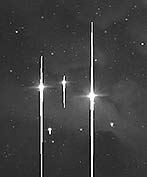 A CCD camera records images by converting photons of light into electrons. The electrons are temporarily stored in individual picture elements (pixels) on a photosensitive detector or chip. At the end of an exposure, the accumulated charges are read off the chip and sent to your computer for conversion to an image.
A CCD camera records images by converting photons of light into electrons. The electrons are temporarily stored in individual picture elements (pixels) on a photosensitive detector or chip. At the end of an exposure, the accumulated charges are read off the chip and sent to your computer for conversion to an image.
During the long exposures needed to record faint objects, bright stars in the field can exceed the full well capacity (the electron-holding capacity) of the pixels on which they are being recorded. As a light-gathering pixel exceeds its capacity to hold captured photons, the excess energy spills over into the adjacent pixel (or pixels, if the second pixel also fills to its capacity). This spillover, called "blooming," produces a spike of light on every bright star in the image. It is often seen in CCD pictures taken with cameras without antiblooming, as shown in the image.
An antiblooming grid (ABG) is a metallic grid placed over the imaging chip. The metallic antiblooming grid drains off the excess energy from each pixel before that energy can spill over into the adjacent pixel. It allows you to take high-quality images without the danger of bright stars blooming before fainter objects are fully imaged.
The drawback of this system is that the metallic antiblooming grid covers a portion of each pixel, reducing the pixel's capacity to collect light. Scientific measurements can be compromised by this reduced capacity, as the response of the detector is no longer linear. A hundred thousand units of light coming in during a long exposure may result in only fifty thousand units of light being recorded by a chip with an antiblooming grid. This will make a particular object look only half as bright as it actually is. This non-linearity is unacceptable for accurate scientific measurements, such as spectroscopy and photometry, but is perfectly acceptable for purely imaging purposes.
If you plan on doing any measurements with your CCD camera, a non-antiblooming camera is the best choice because of the higher accuracy possible without ABG. Casual astrophotographers will have to take a little more care in setting exposure times with a non-antiblooming camera, as they will not have the cosmetic protection of the ABG's arbitrary bright signal cutoff. That being said, it should be noted that non-antiblooming chip cameras are the most popular with casual imagers and scientists alike.








